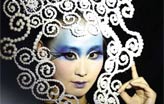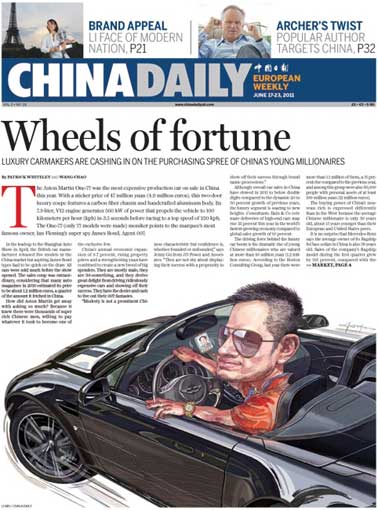Hunger for luxury goods growing
Updated: 2011-06-17 11:14
By Ellen Jin (China Daily European Weekly)
Companies finding it difficult to establish a niche, increase market share
 |
China is continuing its march toward becoming the largest luxury market in the world. The nation is now seen as a second home to many of the world's top brands, with everything from cars, handbags, watches, clothes and fine wines now sold in China.
Every year this market has grown more crowded, and it is becoming harder for luxury brands to tap into this market. The competition to grab a share of the Chinese wallet is immense now for luxury players.
A new survey by KPMG titled, "Luxury experiences in China", has highlighted the increasing brand recognition among Chinese consumers, at 57 brands this year compared with 45 last year.
Luxury brands are finding it increasingly difficult to find a niche and build market share. Amid rising competition, brands need to be innovative and explore new marketing avenues to stay ahead.
These findings are based on a survey of 1,200 consumers in 24 tier-one and tier-two cities across China, conducted by market research company TNS. Respondents were between 20-45 years of age, earning a minimum of 7,500 yuan (798.6 euros) per month in tier-one cities and 5,500 yuan elsewhere.
The survey also finds that China's luxury buyers are basing their purchasing decisions on a wider range of factors. Consumers increasingly choose to reward or pamper themselves as opposed to seeking higher social status via their brand purchases.
Emotive factors such as "experience" and "self-reward" have now emerged alongside status-seeking and needs-based factors as key drivers. They also continue to place a lot of importance on the heritage of luxury brands.
We see signs of a new wave of luxury collecting and connoisseurship that is particularly evident among the wealthy in tier-two and tier-three cities. While the past year has seen an explosion of interest in fine wine, the survey suggests that jewelry, fine art and antiques also have strong growth potential.
With increased opportunities for Chinese to travel overseas, and many people now investing in more luxurious residential properties, there are a wider range of environments in which people can choose to consume and experience luxury. Lifestyle expenditures on health and beauty treatments and spas are also rising.
In terms of the most popular brands, French, Italian and Hong Kong brands have emerged as the top choices for purchases by China's luxury-conscious consumers.
The survey found that consumers in China increasingly associate various countries and regions with particular products. French and Italian products grabbed the first and second positions, while Hong Kong products are the third most popular.
Hong Kong's jewelry brands are popular with Chinese consumers, with several Hong Kong-owned premium clothing brands also doing well in China.
Chinese consumers meanwhile prefer domestic alcohol brands that win the top spot in this category (37 percent), thanks to the popularity of Chinese liquor. French cosmetics and perfumes sold in China (76 percent), fashion (37 percent) and bags (33 percent) notched up the highest percentages in these categories. Italian brands gained the top spot for footwear (43 percent) and Switzerland for watches (87 percent).
Unique to China is the large number of relatively young multimillionaires, far younger than their Western counterparts. This spells opportunities for brands using new technologies to interact with a younger consumer generation.
Digital marketing and building online sales formats are being combined with the in-store experience. The survey found that nearly 70 percent of respondents said they search online for information on luxury brands at least once a month, while 30 percent do so more than once a week.
While official brand websites are often used as the first point of call for specific product information, celebrity blogs and other micro blogs also play an important role when building a brand image in China.
Luxury companies therefore need to think about how their strategies reach key online influencers.
Advertising and marketing channels in China are fragmented in terms of location and ownership of media. With the advent of digital media they increasingly vary. Brands face a range of choices as they develop their marketing mix, each with the potential to impact consumer sentiment in different ways.
Holding lavish events has been a popular approach for building prestige around a brand in major cities such as Shanghai and leading brands compete fiercely for prime magazine and outdoor advertising space. As brands seek to extend their reach to more cities and provinces, many companies may need to consider a more multi-pronged approach.
The traditional entry route for overseas brands has been through partnerships with local franchises and distributors. In recent years, as the business landscape has become more open and transparent, many companies have now fully acquired their retail operations in China, including some that have entered the market directly with a wholly foreign-owned enterprise model.
Brands are therefore adopting a number of approaches in this market - some are doing everything they can to create a complete experience locally for their customers, by for example, carrying a full range of products in their China-based boutiques.
In order to succeed, it is important for brands to have a long-term punt on the China market. It takes a number of years for new entrants to turn a profit, as they need to initially invest in stores, advertising, and building their brands. Those that have been in China for the past 10-20 years are extremely profitable. This is a huge market for them, as they take advantage of improved retail environments in key travel and tourism hubs such as airports.
The author is partner-in-charge, Consumer Markets, KPMG China.
E-paper

Pret-a-design
China is taking bigger strides to become a force in fashion.
Lasting Spirit
Running with the Beijingers
A twist in the tale
Specials

Mom’s the word
Italian expat struggles with learning English and experiences the joys of motherhood again.

Lenovo's challenge
Computer maker takes on iconic brand apple with range of stylish, popular products

Big win
After winning her first major title, Chinese tennis star could be marketing ace for foreign brands
